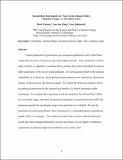Second-best instruments for near-term climate policy: Intensity targets vs. the safety valve
Author(s)
Webster, Mort; Sue Wing, Ian; Jakobovits, Lisa
DownloadWebster_Second Best (BU).pdf (604.4Kb)
PUBLISHER_CC
Publisher with Creative Commons License
Creative Commons Attribution
Terms of use
Metadata
Show full item recordAbstract
Current proposals for greenhouse gas emissions regulations in the United States mainly take the form of emissions caps with tradable permits. Since Weitzman's (1974) [3] study of prices vs. quantities, economic theory predicts that a price instrument is superior under uncertainty in the case of stock pollutants. Given the general belief in the political infeasibility of a carbon tax in the US, there has been recent interest in two other policy instrument designs: hybrid policies and intensity targets. We extend the Weitzman model to derive an analytical expression for the expected net benefits of a hybrid instrument under uncertainty. We compare this expression to one developed by Newell and Pizer (2006) [6] for an intensity target, and show the theoretical minimum correlation between GDP and emissions required for an intensity target to be preferred over a hybrid. In general, we show that unrealistically high correlations are required for the intensity target to be preferred to a hybrid, making a hybrid a more practical instrument in practice. We test the predictions by performing Monte Carlo simulation on a computable general equilibrium model of the US economy. The results are similar, and we show with the numerical model that when marginal abatement costs are non-linear, an even higher correlation is required for an intensity target to be preferred over a safety valve.
Date issued
2010-03Department
Massachusetts Institute of Technology. Joint Program on the Science & Policy of Global ChangeJournal
Journal of Environmental Economics and Management
Publisher
Elsevier
Citation
Webster, Mort, Ian Sue Wing, and Lisa Jakobovits. “Second-Best Instruments for Near-Term Climate Policy: Intensity Targets vs. the Safety Valve.” Journal of Environmental Economics and Management 59, no. 3 (May 2010): 250–259.
Version: Author's final manuscript
ISSN
00950696
1096-0449